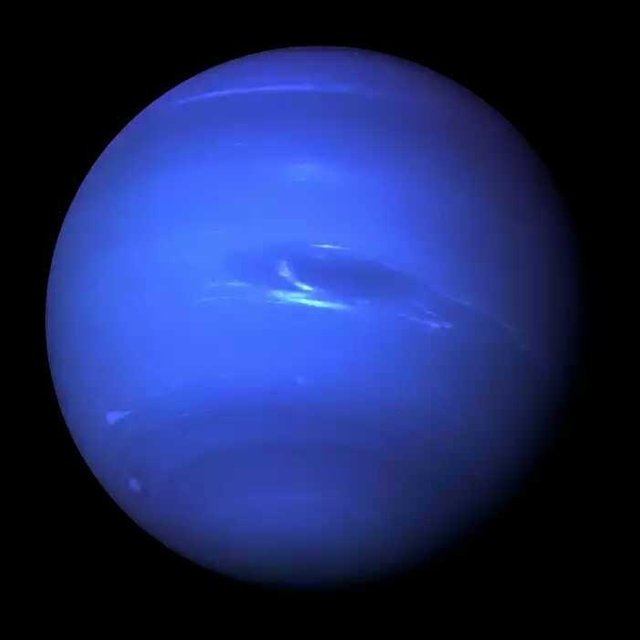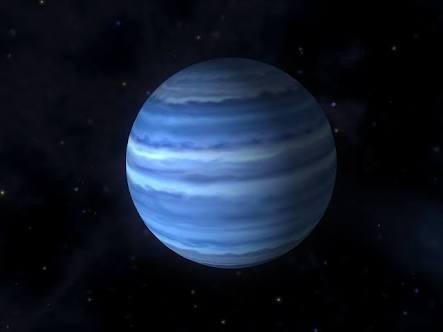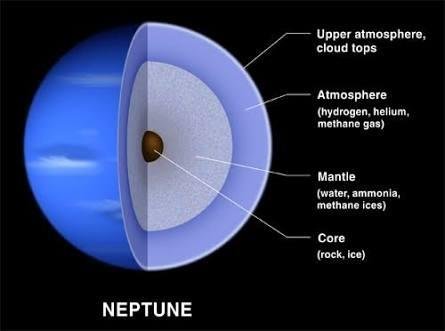Interesting Facts about Planet Neptune

Neptune is the eighth and farthest known planet from the Sun in the Solar System. In the Solar System, it is the fourth-largest planet by diameter, the third-most-massive planet, and the densest giant planet. Neptune is 17 times the mass of Earth and is slightly more massive than its near-twin Uranus, which is 15 times the mass of Earth and slightly larger than Neptune.Neptune orbits the Sun once every 164.8 years at an average distance of 30.1 astronomical units (4.50×109 km). It is named after the Roman god of the sea and has the astronomical symbol ♆, a stylised version of the god Neptune's trident.
Neptune is not visible to the unaided eye and is the only planet in the Solar System found by mathematical prediction rather than by empirical observation. Unexpected changes in the orbit of Uranus led Alexis Bouvard to deduce that its orbit was subject to gravitational perturbation by an unknown planet. Neptune was subsequently observed with a telescope on 23 September 1846 by Johann Galle within a degree of the position predicted by Urbain Le Verrier. Its largest moon, Triton, was discovered shortly thereafter, though none of the planet's remaining known 14 moons were located telescopically until the 20th century. The planet's distance from Earth gives it a very small apparent size, making it challenging to study with Earth-based telescopes. Neptune was visited by Voyager 2, when it flew by the planet on 25 August 1989.The advent of the Hubble Space Telescope and large ground-based telescopes with adaptive optics has recently allowed for additional detailed observations from afar.
Like Jupiter and Saturn, Neptune's atmosphere is composed primarily of hydrogen and helium, along with traces of hydrocarbons and possibly nitrogen, but it contains a higher proportion of "ices" such as water, ammonia, and methane. However, its interior, like that of Uranus, is primarily composed of ices and rock,which is why Uranus and Neptune are normally considered "ice giants" to emphasise this distinction. Traces of methane in the outermost regions in part account for the planet's blue appearance.
In contrast to the hazy, relatively featureless atmosphere of Uranus, Neptune's atmosphere has active and visible weather patterns. For example, at the time of the Voyager 2 flyby in 1989, the planet's southern hemisphere had a Great Dark Spot comparable to the Great Red Spot on Jupiter. These weather patterns are driven by the strongest sustained winds of any planet in the Solar System, with recorded wind speeds as high as 2,100 kilometres per hour (580 m/s; 1,300 mph).Because of its great distance from the Sun, Neptune's outer atmosphere is one of the coldest places in the Solar System, with temperatures at its cloud tops approaching 55 K (−218 °C). Temperatures at the planet's centre are approximately 5,400 K (5,100 °C). Neptune has a faint and fragmented ring system (labelled "arcs"), which was discovered in 1982, then later confirmed by Voyager 2.
History

Some of the earliest recorded observations ever made through a telescope, Galileo's drawings on 28 December 1612 and 27 January 1613, contain plotted points that match up with what is now known to be the position of Neptune. On both occasions, Galileo seems to have mistaken Neptune for a fixed star when it appeared close—in conjunction—to Jupiter in the night sky; hence, he is not credited with Neptune's discovery. At his first observation in December 1612, Neptune was almost stationary in the sky because it had just turned retrograde that day. This apparent backward motion is created when Earth's orbit takes it past an outer planet. Because Neptune was only beginning its yearly retrograde cycle, the motion of the planet was far too slight to be detected with Galileo's small telescope.In July 2009, University of Melbourne physicist David Jamieson announced new evidence suggesting that Galileo was at least aware that the "star" he had observed had moved relative to the fixed stars.
In 1821, Alexis Bouvard published astronomical tables of the orbit of Neptune's neighbour Uranus.Subsequent observations revealed substantial deviations from the tables, leading Bouvard to hypothesise that an unknown body was perturbing the orbit through gravitational interaction. In 1843, John Couch Adams began work on the orbit of Uranus using the data he had. Via Cambridge Observatory director James Challis, he requested extra data from Sir George Airy, the Astronomer Royal, who supplied it in February 1844. Adams continued to work in 1845–46 and produced several different estimates of a new planet.

In 1845–46, Urbain Le Verrier, independently of Adams, developed his own calculations but aroused no enthusiasm in his compatriots. In June 1846, upon seeing Le Verrier's first published estimate of the planet's longitude and its similarity to Adams's estimate, Airy persuaded Challis to search for the planet. Challis vainly scoured the sky throughout August and September.
Meanwhile, Le Verrier by letter urged Berlin Observatory astronomer Johann Gottfried Galle to search with the observatory's refractor. Heinrich d'Arrest, a student at the observatory, suggested to Galle that they could compare a recently drawn chart of the sky in the region of Le Verrier's predicted location with the current sky to seek the displacement characteristic of a planet, as opposed to a fixed star. On the evening of 23 September 1846, the day Galle received the letter, he discovered Neptune within 1° of where Le Verrier had predicted it to be, about 12° from Adams' prediction. Challis later realised that he had observed the planet twice, on 4 and 12 August, but did not recognise it as a planet because he lacked an up-to-date star map and was distracted by his concurrent work on comet observations.
In the wake of the discovery, there was much nationalistic rivalry between the French and the British over who deserved credit for the discovery. Eventually, an international consensus emerged that both Le Verrier and Adams jointly deserved credit. Since 1966, Dennis Rawlins has questioned the credibility of Adams's claim to co-discovery, and the issue was re-evaluated by historians with the return in 1998 of the "Neptune papers" (historical documents) to the Royal Observatory, Greenwich. After reviewing the documents, they suggest that "Adams does not deserve equal credit with Le Verrier for the discovery of Neptune. That credit belongs only to the person who succeeded both in predicting the planet's place and in convincing astronomers to search for it."
Facts About Neptune

1.Neptune was not known to the ancients.
It is not visible to the naked eye and was first observed in 1846. Its position was determined using mathematical predictions. It was named after the Roman god of the sea.
2.Neptune spins on its axis very rapidly.
Its equatorial clouds take 18 hours to make one rotation. This is because Neptune is not solid body.
3.Neptune is the smallest of the ice giants.
Despite being smaller than Uranus, Neptune has a greater mass. Below its heavy atmosphere, Uranus is made of layers of hydrogen, helium, and methane gases. They enclose a layer of water, ammonia and methane ice. The inner core of the planet is made of rock.
4.The atmosphere of Neptune is made of hydrogen and helium, with some methane.
The methane absorbs red light, which makes the planet appear a lovely blue. High, thin clouds drift in the upper atmosphere.
5.Neptune has a very active climate.
Large storms whirl through its upper atmosphere, and high-speed winds track around the planet at up 600 meters per second. One of the largest storms ever seen was recorded in 1989. It was called the Great Dark Spot. It lasted about five years.
6.Neptune has a very thin collection of rings.
They are likely made up of ice particles mixed with dust grains and possibly coated with a carbon-based substance.
7.Neptune has 14 moons.
The most interesting moon is Triton, a frozen world that is spewing nitrogen ice and dust particles out from below its surface. It was likely captured by the gravitational pull of Neptune. It is probably the coldest world in the solar system.
8.Only one spacecraft has flown by Neptune.
In 1989, the Voyager 2 spacecraft swept past the planet. It returned the first close-up images of the Neptune system. The NASA/ESA Hubble Space Telescope has also studied this planet, as have a number of ground-based telescopes.
Neptune’s Great Dark Spot
The Great Dark Spot in the southern atmosphere of Neptune was first discovered in 1989 by the Voyager 2 spacecraft. It was an incredibly large rotating storm system with winds of upto 1,500 miles per hour, the strongest winds recorded on any planet. How such powerful winds were discovered on a planet so far from the sun is still considered a mystery to this day.
Data from the Voyager 2 spacecraft also showed that the Great Dark Spot varied significantly in size during their brief pass of the planet. When Neptune was viewed by the Hubble Space telescope in 1994 the Great Dark Spot had vanished, although a different dark spot had appeared in Neptune’s northern hemisphere.
Neptune’s Atmosphere
Neptune has an incredibly thick atmosphere comprised of 74% hydrogen, 25% helium and approximately 1% methane. Its atmosphere also contains icy clouds and the fastest winds recorded in the solar system. Particles of icy methane and minor gases in the extremities of the atmosphere give Neptune its deep blue colour. The striking blue and white features of Neptune also help to distinguish it from Uranus.
Neptune’s atmosphere is subdivided into the lower troposphere and the stratosphere with the tropopause being the boundary between the two. In the lower troposphere temperatures decrease with altitude however they increase with altitude in the stratosphere. Hydrocarbons form hazes of smog that appear in the entire upper atmosphere of Neptune and hydrocarbon snowflakes that form in Neptune’s atmosphere melt before they reach its surface due to the high pressure.
Some lines copied from wikipedia
Thank You @sujoy1995
Excellent Article. Thanks for this sharing
so unic topic